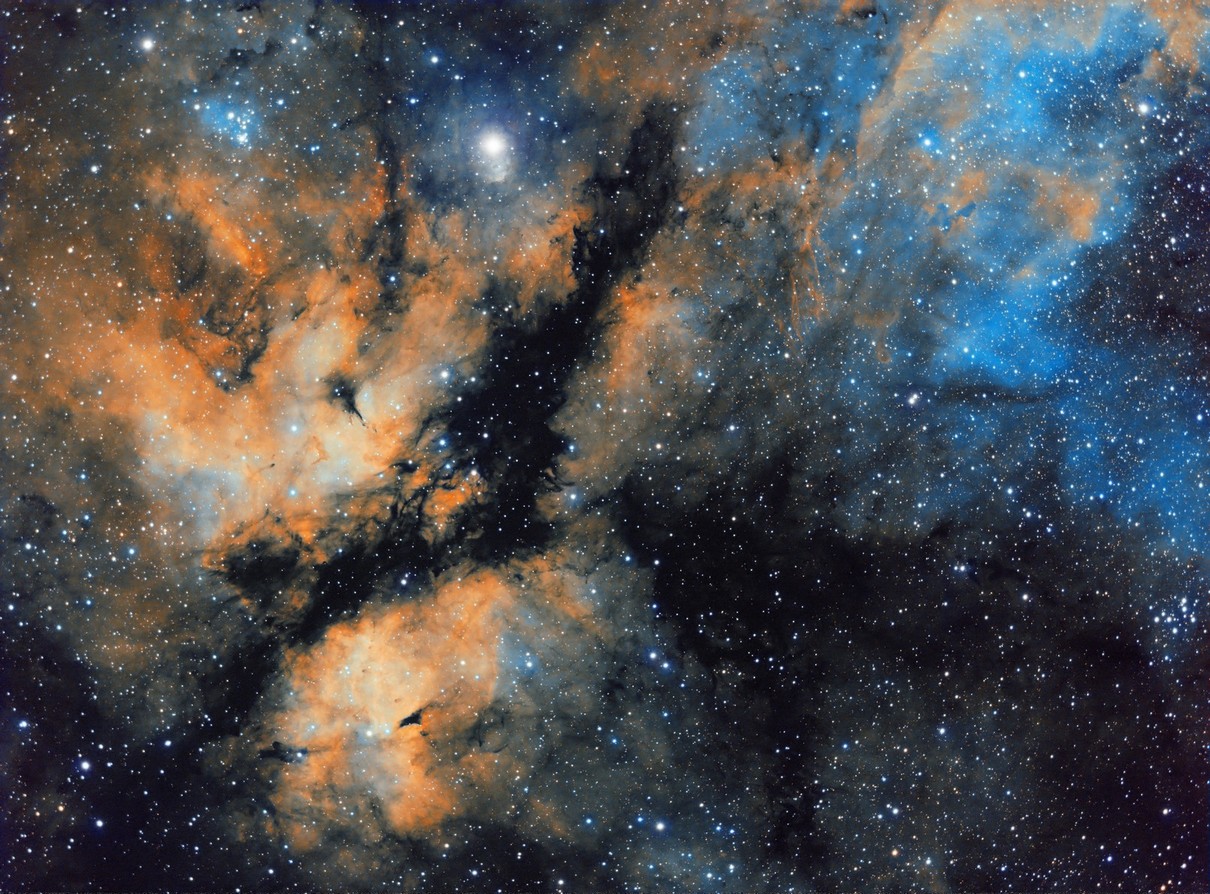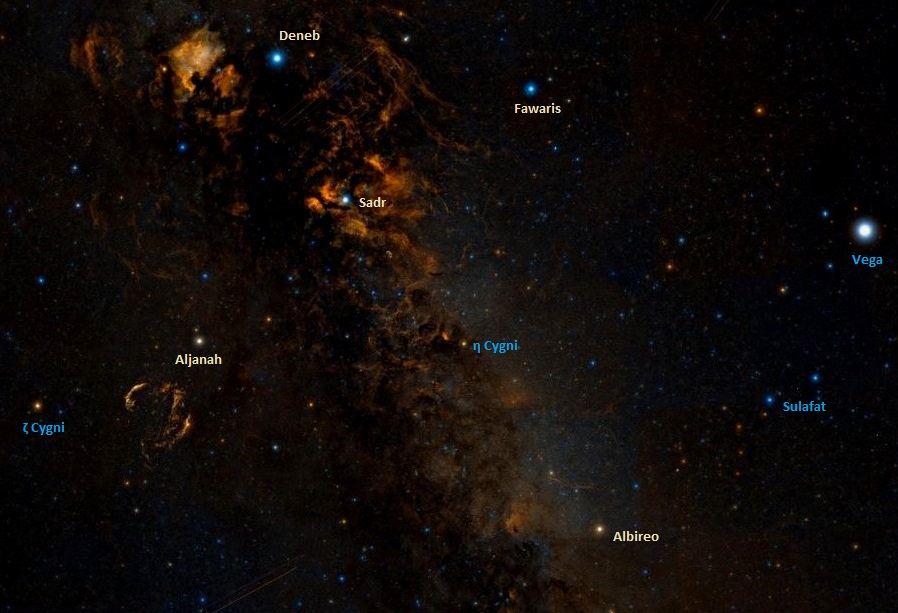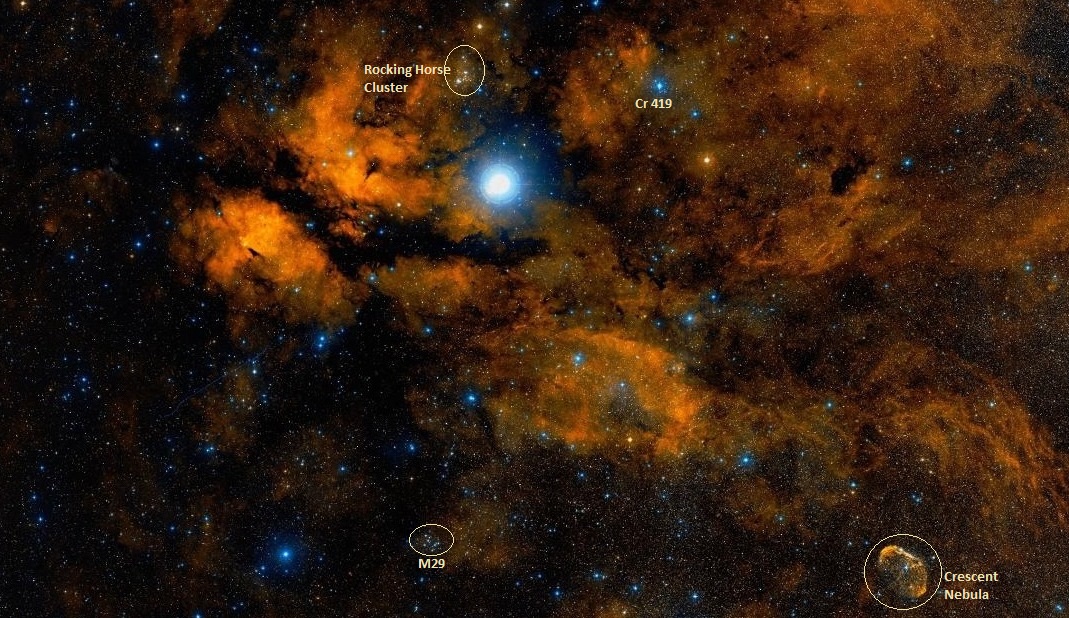Sadr, Gamma Cygni (γ Cyg) is a yellow-white supergiant star located in the constellation Cygnus. With an apparent magnitude of 2.23, it is the constellation’s second brightest star, after Deneb. Sadr lies at an approximate distance of 1,800 light years from Earth. It is the star that marks the intersection of the Northern Cross, a bright asterism that dominates the summer sky in the northern hemisphere. Sadr lies in a rich field of the Milky Way and is surrounded by the diffuse emission nebula IC 1318, also known as the Gamma Cygni Nebula or Sadr Region.
Star type
Sadr is a supergiant star of the spectral type F8 Iab, appearing yellow-white in colour. It has a mass 12.11 times that of the Sun and has expanded to a size of about 150 solar radii. With a surface temperature of 5,790 K, the star has a bolometric luminosity 33,023 times that of the Sun. Its estimated age is 12 million years. Even though it is relatively young, it has already evolved away from the main sequence and its mass seals its supernova fate down the line.
Sadr is the primary component of a multiple star system catalogued as WDS J20222+4015. It is commonly referred to as the “A” component, while the secondary component, catalogued as CCDM J20222+4015BC, is called the “BC” component. The secondary component is separated by 40’’ from Sadr and is just a visual companion.
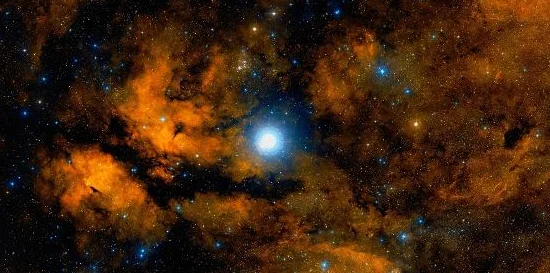
Sadr (Gamma Cygni), image: Wikisky
IC 1318
Sadr is surrounded by the emission nebula IC 1318, one of the several nebulous regions at the centre of the Northern Cross. IC 1318 is known as the Gamma Cygni Nebula, Sadr Region or the Butterfly Nebula. It is not physically related to Sadr, but merely lies in the same line of sight. The nebula is located much farther away than the star, at a distance of 4,900 light years. The star that illuminates IC 1318 is a hot, blue O9-class star obscured by interstellar dust.
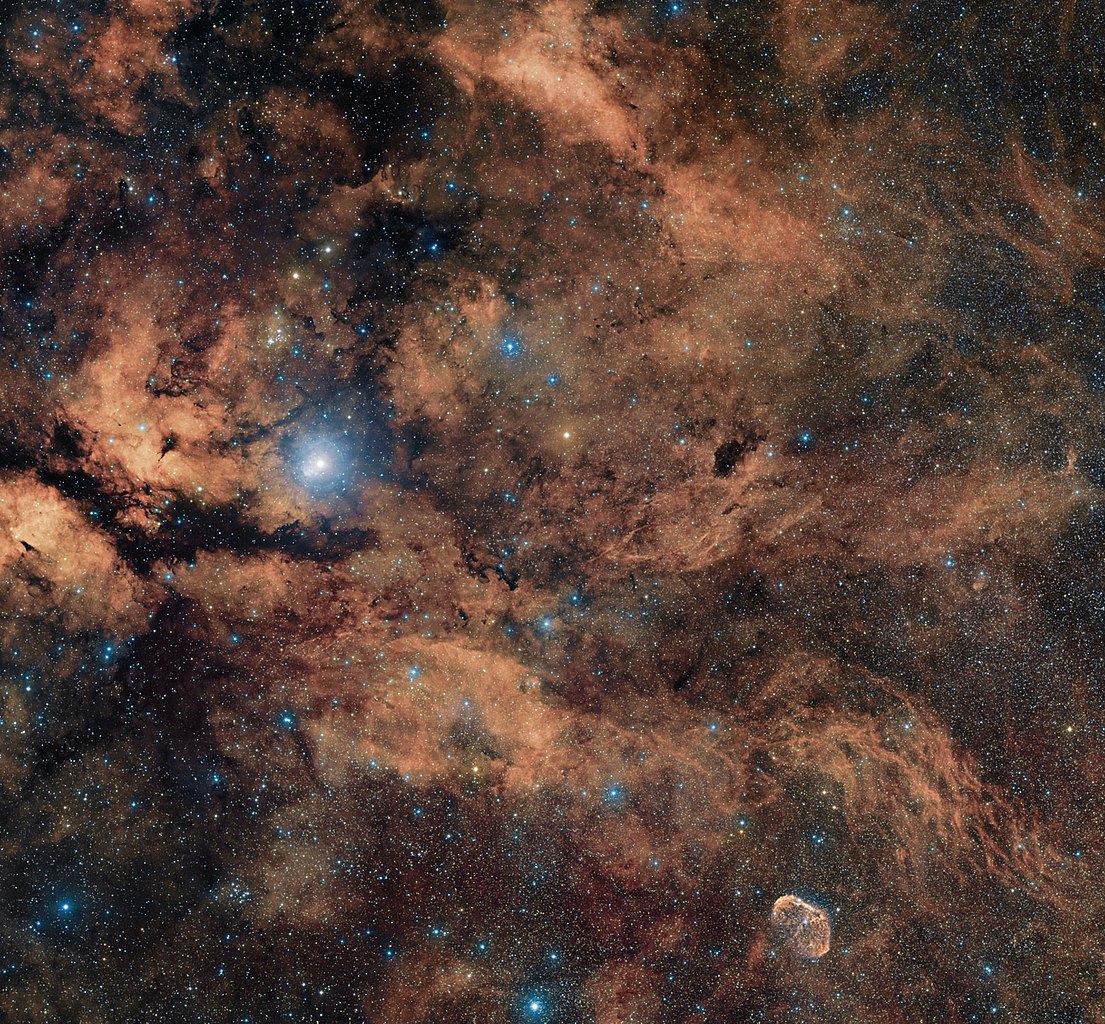
Sadr Region (IC 1318), image: Giuseppe Donatiello (CC0 1.0)
Facts
Sadr is the central star of the Northern Cross, also formed by the bright Deneb (Alpha Cygni), Albireo (Beta Cygni), Aljanah (Epsilon Cygni) and Fawaris (Delta Cygni). Deneb, Sadr and Albireo form the pole of the cross, while Aljanah and Fawaris mark the crossbeam.
The spectrum of Sadr has served as one of the anchor points for the Morgan-Keenan (MK) system of stellar classification, used to classify other stars, since 1943.
Name
The name Sadr (pronunciation: /ˈsædər/) comes from the Arabic ṣadr, meaning “chest.” It has the same etymology as the name of Alpha Cassiopeiae, Schedar. The name has also been spelled Sadir or Sador. It refers to the star’s position in the constellation, marking the Swan’s chest.
The name was officially approved by the International Astronomical Union’s (IAU) Working Group on Star Names (WGSN) on August 21, 2016. It formally applies only to Gamma Cygni A.
Egyptian astronomer Al Achsasi al Mouakket listed the star as Sadr al Dedjadjet, meaning “the hen’s chest,” in his Calendarium, written in the 17th century. The name was later translated into Latin as Pectus Gallinae.
The Chinese name for Sadr is 天津一 (Tiān Jīn yī), or the First Star of Celestial Ford. In Chinese astronomy, Sadr is part of an asterism called Celestial Ford, also formed by Deneb (Alpha Cygni), Fawaris (Delta Cygni), 30 Cygni, Nu Cygni, Tau Cygni, Upsilon Cygni, Zeta Cygni, and Aljanah (Epsilon Cygni).
Location
Sadr is very easy to find because it lies at the intersection of the bright, large Northern Cross asterism. The Northern Cross is easy to spot on a clear night. It lies within the larger Summer Triangle, a brighter summer asterism formed by Deneb with Vega in the constellation Lyra and Altair in Aquila.
Sadr is located in the vicinity of several interesting deep sky objects. The Rocking Horse Cluster (NGC 6910) is an open cluster located only half a degree east and a little north of the star. It is at a similar distance as the Gamma Cygni Nebula and may be physically associated with it. The cluster has an apparent magnitude of 7.4 and occupies an area of 10’. The neighbouring open cluster Collinder 419 (Cr 419) is only slightly fainter, with a visual magnitude of 7.60.
The open cluster Messier 29 lies 1.7 degrees south and a little east of the star, while the emission nebula NGC 6888, also known as the Crescent Nebula, can be found about 2 degrees southwest of Sadr.
Constellation
Sadr is located in the constellation Cygnus. Representing the celestial Swan, Cygnus is one of the larger northern constellations, stretching across 804 square degrees of the apparent sky. It is known mainly for the Northern Cross and its bright stars Deneb, the 19th brightest star in the sky, and Albireo, a famous contrasting double star.
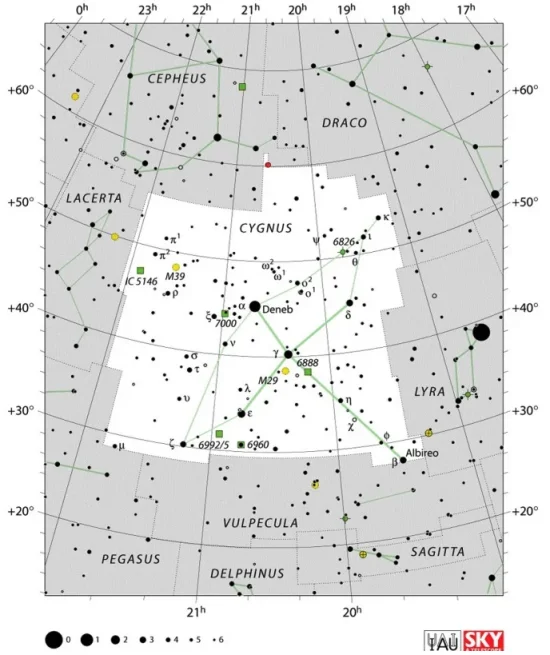
Cygnus constellation map by IAU and Sky&Telescope magazine
The constellation contains a number of well-known deep sky objects, among others the bright open clusters Messier 29, Messier 39 and NGC 6910, the Fireworks Galaxy (NGC 6946), and several bright nebulae, including the North America Nebula (NGC 7000), the Pelican Nebula (IC 5070), the Veil Nebula (NGC 6960, 6962, 6979, 6992 and 6995), the Blinking Planetary Nebula (NGC 6826), and the nebulae near Sadr: the Gamma Cygni Nebula (IC 1318) and the Crescent Nebula (NGC 6888).
The best time of year to see the stars and deep sky objects in the constellation is during the month of September.
The 10 brightest stars in Cygnus are Deneb (Alpha Cyg, mag. 1.25), Sadr (Gamma Cyg, mag. 2.23), Aljanah (Epsilon Cyg, mag. 2.48), Fawaris (Delta Cyg, mag. 2.87), Albireo (Beta Cyg, mag. 2.90), Zeta Cygni (mag. 3.21), Xi Cygni (mag. 3.73), Tau Cygni (mag. 3.65 – 3.75), Iota2 Cygni (mag. 3.77), and Kappa Cygni (mag. 3.814).
Sadr – Gamma Cygni
| Spectral class | F8 Iab |
| Variable type | suspected |
| U-B colour index | +0.54 |
| B-V colour index | +0.67 |
| Apparent magnitude | 2.23 |
| Absolute magnitude | −4.54 |
| Distance | ~ 1,800 light years (560 parsecs) |
| Parallax | 1.78 ± 0.27 mas |
| Radial velocity | -7.5 km/s |
| Proper motion | RA: +2.39 mas/yr |
| Dec.: -0.91 mas/yr | |
| Mass | 12.11 ± 0.71 M☉ |
| Luminosity | 33,023 L☉ |
| Radius | 150 ± 80 R☉ |
| Temperature | 5,790 ± 100 K |
| Metallicity | +0.02 dex |
| Age | 12 million years |
| Rotational velocity | 15 km/s |
| Surface gravity | 1.02 ± 0.10 cgs |
| Constellation | Cygnus |
| Right ascension | 20h 22m 13.70184s |
| Declination | +40° 15′ 24.0450″ |
| Designations | Sadr, Gamma Cygni, γ Cyg, 37 Cygni, HD 194093, HR 7796, HIP 100453, GC 28338, GCRV 12723, FK5 765, SAO 49528, PPM 59799, BD+39°4159, Gaia DR2 2067518817313277952, WDS J20222+4015A, IRAS 20204+4005, 2MASS J20221370+4015241, TYC 3156-2223-1 |
